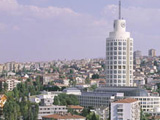|
|
TODAY.AZ / World news
Nearly 4 million Turkish women are illiterate, report says
02 February 2011 [12:30] - TODAY.AZ
 Nearly 4 million women in Turkey – just over 10 percent of the female population – are illiterate, according to a new report that has shown a major gender discrepancy in the ability to read and write.
Nearly 4 million women in Turkey – just over 10 percent of the female population – are illiterate, according to a new report that has shown a major gender discrepancy in the ability to read and write.Of the 4,672,257 illiterate people in Turkey, 3,757,203 are women, with the majority over the age of 50, said the national report titled “The Situation of Women in Turkey.”
Prepared by the Directorate General on the Status of Women using data collected by the Turkish Statistical Institute, or TurkStat, in 2009, the report made the connection between illiteracy rates and the low levels of female participation in the workforce.
The percentage of working women dropped from 34.1 percent in 1990 to 26 percent in 2009. The rate is 22.3 percent in urban areas and 34.6 percent in rural areas.
Of women who work, 43.7 percent are employed in the services sector, 41.7 percent in the agricultural sector and 14.6 percent in the industrial sector. Some 12.8 are bosses, 51.1 percent are employees and 34.8 percent perform unpaid labor for their families.
Women at work
While female academics are well represented in Turkey, at 38.7 percent, the report said men typically hold the higher-level positions at universities. Women make up only 5.2 percent of all rectors and 15.3 percent of all deans.
The situation is similar in politics and public life, where there are just 27 women among the country’s 2,948 mayors. Of the 110 ambassadors representing Turkey abroad, only 11 are women. Women also account for only 7 percent of high-level civil servants.
On the other hand, the rate of women in specialist vocations is higher than in many other countries, at 41.5 percent.
Illiteracy more common among older women
The Directorate General on the Status of Women’s report found that 2.5 million of the illiterate women in the country are above the age of 50, while 220,000 are between the ages of 6 and 24.
According to the TurkStat data, there are 18.5 million people in Turkey with only a primary-school education: 9,586,552 are female and 8,937,271 are male. Among high-school graduates, 4,376,541 are female and 6,200,688 are male. Of the country’s 4,320,813 university graduates, 1,786,379 are female and 2,534,434 are male.
The ranks of literate women in Turkey include 6,933,483 who do not have a school diploma but can read.
In a sign that the situation may be changing, women account for 44 percent of the country’s 3,529,334 university students. According to the report, the increase in the number of female teachers in primary schools may have caused the parents of female students to allow them to go to school.
Overall, the rate of primary school enrollment increased to 98.17 percent in the 2009-2010 school year, up from 84.7 percent in the 1997-1998 school year. The lowest rates of enrollment were observed in the Southeastern Anatolian provinces of Bitlis (84.27 percent), Van (84.57 percent) and Hakkari (85.05 percent). The highest enrollment rates are seen in Ankara, with 99.31 percent, followed by İzmir, with 99.18 percent, and Mersin, with 99.01 percent.
In its report, the directorate said the country’s aim is to reach 100 percent enrollment by 2013.
Maternal mortality
The report also showed that the maternal mortality rate in the country is 18.2 out of 100,000. Stressing that care should be taken during pregnancy, the report said 92 percent of Turkish women overall take special care in this period. In Eastern Turkey, mostly in rural provinces, that figure falls to 80 percent.
/Hurriyet Daily News/
URL: http://www.today.az/news/regions/80284.html
 Print version
Print version
Views: 1721
Connect with us. Get latest news and updates.
See Also
- 29 August 2025 [21:50]
Japan and India pledge stronger economic and security ties - 29 August 2025 [13:49]
Armenian consul arrested over alleged espionage for Azerbaijan - 29 August 2025 [13:36]
Germany tells nationals to leave Iran, fearing retaliation over sanctions - 29 August 2025 [11:03]
Modernization of old inefficient boiler houses continues across Azerbaijan - 29 August 2025 [09:00]
Samsung to reveal new Galaxy products at upcoming Berlin event - 29 August 2025 [08:00]
WhatsApp now lets you write messages using AI - 28 August 2025 [23:33]
Turkish business community backs rate cuts amid inflation battle - 28 August 2025 [22:50]
Sweden proposes to ban sale of phones - 28 August 2025 [22:23]
National Solidarity Commission pushes forward unique model against terror - 28 August 2025 [21:22]
Minister Uralo?lu highlights strategic importance of Zangazur Corridor and new railway projects
Most Popular
 Baku has put all the dots above the "I" in the issue of the Zangezur corridor
Baku has put all the dots above the "I" in the issue of the Zangezur corridor
 Youth Camp of CIS Countries wraps up in Lachin
Youth Camp of CIS Countries wraps up in Lachin
 Azerbaijan, Uganda explore cooperation in the energy sector
Azerbaijan, Uganda explore cooperation in the energy sector
 Azerbaijan, Argentina discuss expansion of economic cooperation
Azerbaijan, Argentina discuss expansion of economic cooperation
 Azerbaijan joins CIS Deputy Prosecutors General meeting in Moscow
Azerbaijan joins CIS Deputy Prosecutors General meeting in Moscow
 Azerbaijan, EIB discuss prospects for stronger partnership
Azerbaijan, EIB discuss prospects for stronger partnership
 Azerbaijani construction products rank among top 3 on Alibaba.com
Azerbaijani construction products rank among top 3 on Alibaba.com
